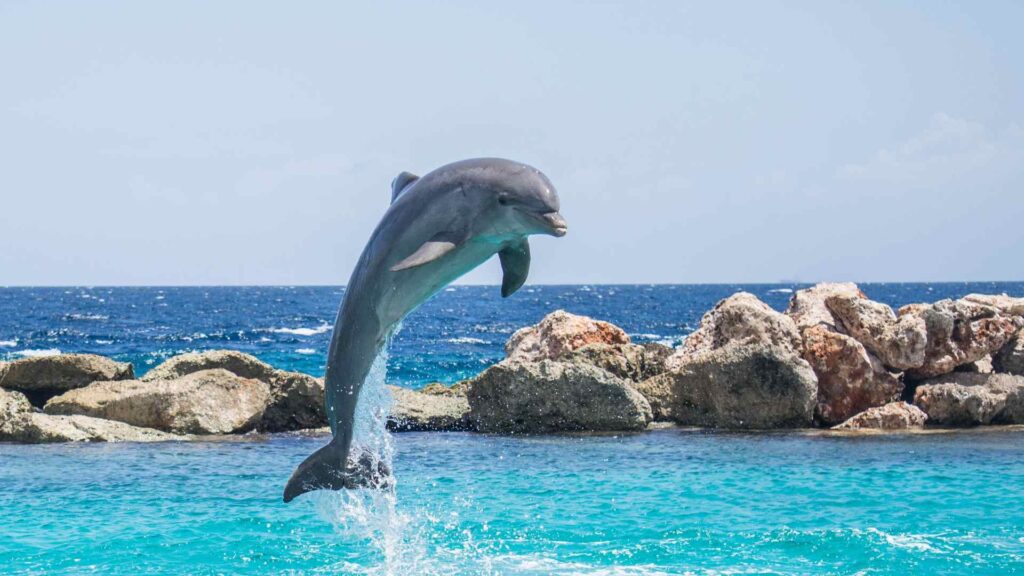Dolphins are some of the ocean’s most fascinating creatures!
Known for their intelligence and playful antics, these aquatic mammals never fail to captivate.
In this ultimate guide, we’ll dive deep into 145 fun facts about dolphins, beautifully categorized to enhance your appreciation of these incredible animals. Let’s make a splash!
Intelligence and Communication
- Dolphins have larger brains relative to their body size than humans.
- They communicate using a complex system of clicks, whistles, and body movements.
- Each dolphin has a unique signature whistle, much like a name.
- Dolphins can understand up to 60 human hand gestures in studies.
- They can mimic human behaviors and even “speak” through underwater microphones.
- Dolphins display self-awareness by recognizing themselves in mirrors.
- They often work together to solve problems, showing remarkable teamwork.
- Bottlenose dolphins can distinguish between different kinds of objects and even understand abstract concepts.
- Dolphins use “echolocation,” a sonar-like system, to locate prey and navigate murky waters.
- Some dolphins have been observed teaching their young how to use tools, such as sponges to protect their noses while foraging.
- They communicate through bubbles and physical touches when hunting or playing.
- Dolphins can remember the sounds of other dolphins for over 20 years.
- Studies show dolphins can count and understand quantities.
- They are known to imitate each other’s signature whistles to “call out” a specific dolphin.
- Dolphins show a range of emotions, including joy, grief, and empathy.

Physical Characteristics and Adaptations
- A dolphin’s skin regenerates every two hours to reduce drag in the water.
- Most dolphins have around 80-100 conical teeth, which they use for grabbing prey, not chewing.
- Dolphins are counter-shaded with a lighter belly and darker back, which helps them camouflage.
- Their blowhole allows them to breathe, and it closes automatically underwater.
- Dolphin fins have unique markings and shapes, much like fingerprints.
- They can swim up to 25 miles per hour in short bursts.
- Dolphins can hold their breath for up to 10 minutes while diving.
- They have a thick layer of blubber for insulation in cooler waters.
- The pectoral fins of dolphins contain bones similar to human hands.
- A dolphin’s eyes can move independently, giving them nearly 360-degree vision.
- They can leap as high as 20 feet above the water’s surface.
- The tail fluke is responsible for a dolphin’s powerful swimming movements.
- Dolphins have acute hearing, even better than most land mammals.
- Their bodies are highly streamlined to minimize water resistance.
- Dolphins shed their outer skin layer up to 12 times a day for efficiency.
Diet and Hunting Habits
- Dolphins eat a diet primarily of fish, squid, and crustaceans.
- They swallow their food whole due to their lack of molars.
- Dolphins often hunt in groups, corralling fish into tight schools for easier feeding.
- They use echolocation to stun prey with sound waves.
- Some dolphins in Brazil cooperate with fishermen to catch fish.
- They are known to use mud to trap fish in shallow waters.
- Dolphins can eat up to 30 pounds of fish daily.
- They share food within pods, showcasing their social behavior.
- Certain dolphin species dive over 1,500 feet to hunt for deep-sea squid.
- They use their tails to slap fish, stunning them before eating.
- Dolphins engage in “strand feeding,” intentionally beaching themselves briefly to catch prey.
- Some dolphins have been seen blowing rings of bubbles to herd prey into a compact area.
- They can adjust their diet based on availability, showing adaptability.
- Spinner dolphins hunt cooperatively during nighttime hours.
- They track prey using a highly sensitive jawbone that detects vibrations.

Social Behavior and Playfulness
- Dolphins live in pods, typically made up of 10-15 individuals, but some pods exceed 1,000 members.
- They play by riding the bow waves of boats and surfing.
- Dolphins have been seen playing games like “catch” with seaweed.
- They babysit calves within pods, showing communal care.
- Social bonds between dolphins can last for decades.
- Dolphins help injured or sick pod members by keeping them afloat.
- They engage in synchronized swimming during social activities.
- Dolphins playfully chase each other and leap out of the water.
- They enjoy interacting with other species, including humans.
- Some dolphins form alliances for better hunting and protection.
- They participate in mating displays, leaping and spinning to attract mates.
- Dolphins have been known to save humans from sharks.
- They frequently use playful body slaps and tail flicks.
- Young dolphins mimic adult behaviors during play.
- They sometimes play with jellyfish, despite the stings.
Dolphins in Culture and Mythology
- In Greek mythology, dolphins were sacred to Poseidon.
- The Roman god Neptune is often depicted with dolphins.
- Dolphins were believed to guide souls to the afterlife in some ancient cultures.
- They have been depicted in art since 1500 BC.
- Ancient sailors considered dolphins a sign of good luck.
- They are mentioned in the works of Aristotle and Pliny the Elder.
- In Maori mythology, dolphins are seen as divine guardians.
- Some cultures believe dolphins bring rain during droughts.
- Early explorers documented dolphins helping stranded sailors.
- They feature prominently in coastal cave paintings.
- Dolphins are used in modern conservation symbols worldwide.
- In Polynesian lore, dolphins were considered messengers of the sea gods.
- They are prominent in eco-tourism industries globally.
- Films like Flipper brought global attention to their intelligence.
- Dolphins are often depicted as peacemakers in modern art.

Bonus Facts
- Dolphins can sleep with one eye open.
- Orcas, the largest members of the dolphin family, are apex predators.
- The Amazon river dolphin is pink due to capillaries near the surface of its skin.
- Dolphins drink no water; they hydrate via their food.
- Baby dolphins, called calves, are born tail-first.
- They communicate across miles with low-frequency clicks.
- Dolphins can swim backward, a rare feat for aquatic animals.
- Some species can live up to 60 years in the wild.
- The Maui’s dolphin is the smallest dolphin, measuring just 4 feet long.
- Dolphins rarely get sick due to their strong immune systems.
- Dolphins can jump out of the water to spot prey and predators.
- They can travel up to 100 miles in a single day.
- The oldest dolphin fossil dates back over 50 million years.
- Dolphins’ smiles are a permanent feature due to the shape of their jaws.
- They have no sense of smell but an excellent sense of taste.
- Dolphin pods use unique hunting strategies tailored to their environments.
- The Dusky dolphin is known for its acrobatic leaps and flips.
- Dolphins are conscious breathers, meaning they must think to breathe.
- Despite living in water, dolphins are mammals and nurse their young.
- Some dolphins hunt using a technique called “kerplunking,” slapping water to scare prey.
- Dolphins rarely interbreed with other dolphin species, but hybrids like “wholphins” exist.
- They can swim deeper than 1,000 feet to forage for food.
- Dolphins often use bubbles to express excitement or alertness.
- They have strong social hierarchies within pods.
- A dolphin’s dorsal fin can help identify its species.
- Spinner dolphins spin up to 10 times in a single leap.
- They rely on highly developed social skills to thrive in the wild.
- Dolphins can sense changes in Earth’s magnetic field.
- They often protect other species, including whales, from predators.
- Female dolphins sometimes “adopt” calves from other pods.
- Dolphins play with seaweed for fun and social bonding.
- Some dolphins create underwater “bubble nets” to trap fish.
- A dolphin’s heart rate slows dramatically when diving to conserve oxygen.
- Dolphins are among the few species that exhibit altruistic behavior.
- Their eyes are protected underwater by a special oily secretion.
- Dolphins enjoy the company of manta rays and turtles.
- They have been observed “people-watching” at coastal resorts.
- Male dolphins sometimes form bachelor pods until they find mates.
- Calves learn to surf waves by observing their mothers.
- Dolphins use clicking sounds to identify an object’s shape and size.
- They can move their pectoral fins in a way that mimics a human handshake.
- The Irrawaddy dolphin thrives in both saltwater and freshwater habitats.
- Dolphins are highly curious and often investigate boats or divers.
- They can sleep in a semi-alert state, known as unihemispheric sleep.
- Dolphins sometimes hunt cooperatively with other dolphin species.
- They have been known to protect humans by warding off sharks.
- Dolphins sometimes strand themselves intentionally to hunt fish on the shore.
- Their streamlined bodies allow them to cut through water effortlessly.
- Dolphins use their powerful tails to leap over obstacles.
- They are known to migrate seasonally in search of warmer waters or food.
- Dolphins can sense the heartbeat of nearby animals using echolocation.
- They sometimes “spy hop,” poking their heads above water to observe surroundings.
- Dolphins have a unique tongue structure that helps them latch onto prey.
- Some dolphins have been trained to detect underwater mines.
- They have an extra layer of muscle in their eyes to enhance vision underwater.
- Dolphins communicate using “burst-pulse” sounds to express frustration.
- Pods often include subgroups divided by age or role.
- They use vocal mimicry to bond with close companions.
- The Risso’s dolphin has a distinctive white body due to scarring from other dolphins.
- Dolphins have complex mating behaviors, including displays of strength and agility.
Conclusion
Dolphins never cease to amaze us with their intelligence, playfulness, and unique adaptations. These 145 fun facts offer a glimpse into the incredible lives of these oceanic marvels.
From their communication skills to their cultural significance, dolphins continue to inspire wonder across the globe.
